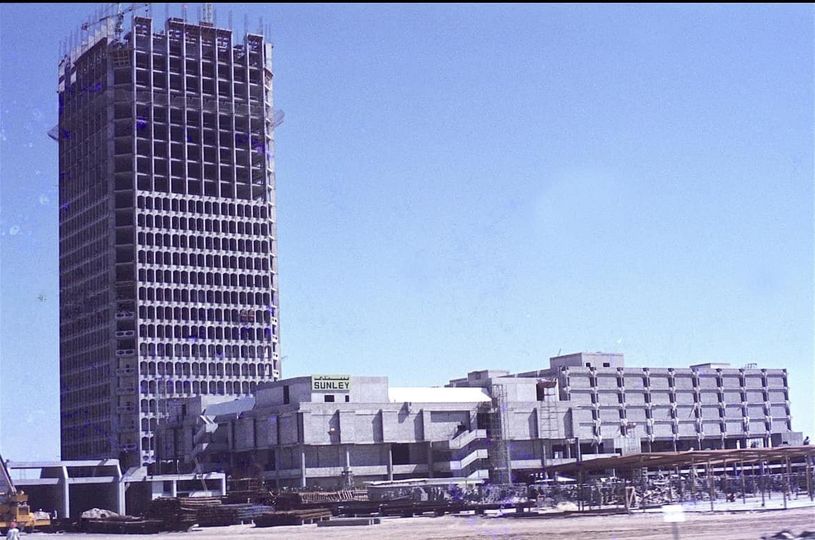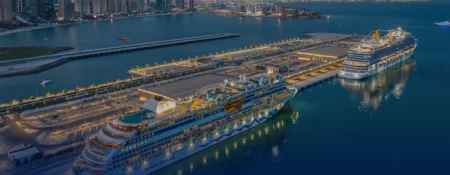The idea to build an iconic Dubai World Trade Centre (DWTC) is believed to have stemmed from Sheikh Rashid bin Saeed Al Maktoum’s grand vision of gradually transforming Dubai into a regional (and later – global) economic hub. Some suggest this vision took root during Sheikh Rashid’s visit to the United States in the 1970s, where he observed the flourishing trade and construction, as well as architecture of big cities at the time.
The story takes an interesting turn with a visit from Queen Elizabeth II. During an unplanned stopover in Dubai on her way back to the UK, the Queen toured a British Trade Exhibition held at Dubai’s new airport terminal alongside Sheikh Rashid. Inspired by this event, Sheikh Rashid envisioned an exhibition center in Dubai to foster international trade and strengthen the emirate’s position as a global business hub. While initial plans were to locate the exhibition complex in a close proximity to the Dubai Airport, logistical challenges eventually prompted to choose an alternative location.

Sheikh Rashid hired a famous British architect John Harris to design the complex. Harris initially proposed a low-rise exhibition center, but Sheikh Rashid insisted on a landmark high-rise tower as its centerpiece. Harris drew inspiration from World Trade Centres in New York, Singapore, and Tokyo, refining his design into a 36-story tower to fit the allocated land.
Interestingly, a competition emerged between Dubai and Abu Dhabi during the planning and construction stages. Both emirates aimed to construct the tallest tower in the UAE, eventually prompting Dubai to increase the number of floors in the DWTC from 36 to 39. Additionally, a mast was added to ensure the building stood taller than its rival in Abu Dhabi. This friendly rivalry not only fueled innovation but also underscored Sheikh Rashid’s determination to position Dubai as a leader in the region.
At the time, the chosen location was considered “remote” and “impractical,” drawing significant criticism. Critics labeled the project as “overambitious” and “unlikely to succeed,” particularly as Sheikh Rashid was simultaneously undertaking other massive projects, such as the Dubai Drydocks and Jebel Ali Port. However, Sheikh Rashid, undeterred by skepticism, saw the potential for the chosen area to become a bustling business district (eventually nicknamed as “The Heart of Dubai”), and DWTC to become the catalyst of its growth. Construction began in 1975 under Bernard Sunley & Co. After four years of construction (in 1979), the main tower of Dubai World Trade Centre was completed. Notably, it was the tallest building in the UAE at the time, featuring 39 stories and a distinctive mast. To enhance its visual appeal, Sheikh Rashid ordered the building’s concrete facade to be painted white, a significant undertaking that ultimately made the DWTC a standout structure on Dubai’s skyline.

Credit: John R Harris Library
The Dubai World Trade Centre was officially inaugurated in 1979 by Queen Elizabeth II herself during her state visit to Dubai. The tower was not only an architectural marvel at the time, but also a bold declaration of Dubai’s ambitions to become a global trade and business hub. It quickly gained iconic status, becoming a landmark tower and one of Dubai’s symbols (to the point of inclusion of the Trade Centre Tower on the 100 AED note).
The DWTC was conceived as a self-contained complex that included serviced apartments and a hotel to support the needs of visiting business people and long-term tenants. The apartments, a first for Dubai at the time, quickly became popular for their modern amenities and community atmosphere. Restaurants, sports facilities, and a club added to its appeal, turning the area into a vibrant neighborhood.
The adjoining Hilton Hotel, which opened in 1978, became a key component of the complex. Known for its gym and fitness club, the hotel served not only international visitors but also Dubai’s residents. By the 2000s, as Dubai’s skyline continued to evolve, the low-rise Hilton Hotel was replaced with high-rise extensions to maximize the value of the prime location. The original Hilton Hotel was demolished in 2007.
Today, the Dubai World Trade Centre is a thriving epicenter of business, events, and exhibitions. It hosts major international trade fairs like Gulfood and GiTex, concerts, conferences and conventions, attracting millions of visitors annually. The surrounding area, once considered remote, is now the heart of Dubai’s bustling financial district – the DIFC. The complex itself has grown to include state-of-the-art exhibition halls, office spaces and multiple luxury hotels, solidifying its reputation as a leading global destination for business and innovation.
The DWTC remains a testament to Sheikh Rashid’s visionary leadership, standing tall as a symbol of Dubai’s remarkable transformation from a modest trading port to a world-class metropolis.



